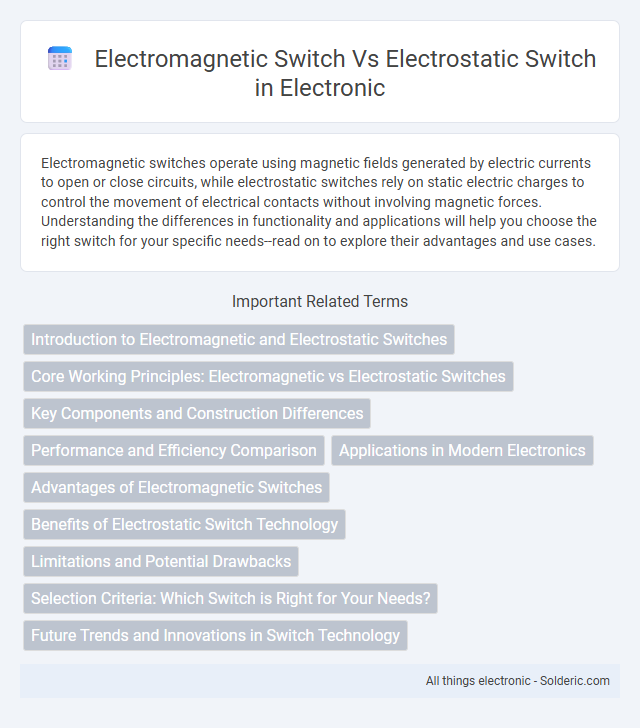Electromagnetic switches operate using magnetic fields generated by electric currents to open or close circuits, while electrostatic switches rely on static electric charges to control the movement of electrical contacts without involving magnetic forces. Understanding the differences in functionality and applications will help you choose the right switch for your specific needs--read on to explore their advantages and use cases.
Comparison Table
| Feature | Electromagnetic Switch | Electrostatic Switch |
|---|---|---|
| Operating Principle | Uses magnetic field generated by current to open/close contacts | Uses electrostatic force from charged plates to actuate switching |
| Power Consumption | Higher due to magnetic coil excitation | Lower, relies on static charge |
| Switching Speed | Moderate, limited by electromagnetic coil response | High, due to fast electrostatic forces |
| Size | Relatively larger, includes coil and magnetic parts | Compact, minimal mechanical parts |
| Durability | Mechanical wear due to moving contacts | Less mechanical wear, higher lifespan |
| Applications | Relays, circuit breakers, automotive switches | Microelectromechanical systems (MEMS), sensors |
| Complexity | Simple electromagnetic design | Requires high voltage control circuitry |
Introduction to Electromagnetic and Electrostatic Switches
Electromagnetic switches operate by using magnetic fields generated by electric current to open or close circuits, making them essential components in relays, contactors, and various electrical devices. Electrostatic switches utilize electrostatic forces created by static electric charges to control circuit operation, often found in microelectromechanical systems (MEMS) and precision switching applications. Understanding the differing principles and applications of these switches helps you select the right technology based on factors such as power consumption, switching speed, and environment sensitivity.
Core Working Principles: Electromagnetic vs Electrostatic Switches
Electromagnetic switches operate by using magnetic fields generated by electric current flowing through coils to mechanically open or close contacts. Electrostatic switches utilize electrostatic forces created by voltage differences between charged plates to control the switching mechanism without moving parts. The fundamental difference lies in electromagnetic switches relying on magnetic induction and mechanical movement, whereas electrostatic switches depend on electrostatic attraction or repulsion for switching action.
Key Components and Construction Differences
An electromagnetic switch primarily consists of a coil, armature, spring, and contacts, relying on magnetic fields generated by electric current to operate. In contrast, an electrostatic switch uses fixed and movable electrodes with an insulating medium, functioning through electrostatic forces without mechanical movement. Understanding these key component differences helps you choose the appropriate switch based on application requirements involving magnetic or electrostatic principles.
Performance and Efficiency Comparison
Electromagnetic switches offer faster response times and higher current capacities, making them ideal for power-intensive applications. Electrostatic switches excel in low-power consumption and minimal heat generation, resulting in greater energy efficiency for sensitive electronic circuits. Performance varies with application demands, as electromagnetic switches provide robust durability, while electrostatic switches ensure precise control with reduced electrical noise.
Applications in Modern Electronics
Electromagnetic switches dominate in applications requiring reliable physical contact, such as motor controls, relays, and industrial automation systems, due to their robust construction and ability to handle high current loads. Electrostatic switches excel in microelectromechanical systems (MEMS), touchscreens, and ultra-low power devices by utilizing electrostatic forces for actuation with minimal energy consumption and rapid response times. Your choice depends on the specific application demands, balancing factors like switching speed, power efficiency, and device scale.
Advantages of Electromagnetic Switches
Electromagnetic switches offer high reliability and fast response times due to their robust mechanical operation driven by electromagnetic coils. They provide excellent current capacity and durability, making them suitable for heavy-duty applications and frequent switching cycles. These switches also exhibit strong resistance to electromagnetic interference, ensuring stable performance in industrial environments.
Benefits of Electrostatic Switch Technology
Electrostatic switch technology offers significant benefits such as lower power consumption and faster switching speeds compared to electromagnetic switches, making it ideal for miniaturized and energy-efficient applications. Its compact size and absence of moving parts contribute to enhanced durability and reduced wear, extending the device's operational lifespan. When precision and reliability in switching are critical, your choice of electrostatic switches can improve overall system performance while minimizing maintenance needs.
Limitations and Potential Drawbacks
Electromagnetic switches often face limitations such as mechanical wear, slower response times, and susceptibility to electromagnetic interference, which can affect durability and precision. Electrostatic switches suffer from low actuation force and sensitivity to environmental factors like humidity and contamination, leading to reliability issues in harsh conditions. Both types require careful consideration of operating environments to mitigate potential drawbacks and ensure optimal performance.
Selection Criteria: Which Switch is Right for Your Needs?
Electromagnetic switches are ideal for applications requiring high switching force, rapid response, and reliable performance in harsh environments, making them suitable for heavy-duty industrial equipment and motors. Electrostatic switches excel in low-power, high-precision circuits with minimal mechanical wear, frequently used in microelectromechanical systems (MEMS) and sensitive electronics. Selecting the right switch depends on factors like operating voltage, switch speed, mechanical durability, power consumption, and environmental conditions specific to the intended application.
Future Trends and Innovations in Switch Technology
Emerging switch technologies emphasize miniaturization and energy efficiency, with electromagnetic switches evolving to incorporate smart sensor integration and IoT connectivity enhancing automated control systems. Electrostatic switches benefit from advancements in microelectromechanical systems (MEMS), enabling ultra-low power consumption and rapid switching speeds critical for wearable devices and flexible electronics. Future trends prioritize materials innovation, such as graphene and nanocomposites, to improve durability and responsiveness in both switch types within diverse applications.
electromagnetic switch vs electrostatic switch Infographic

 solderic.com
solderic.com